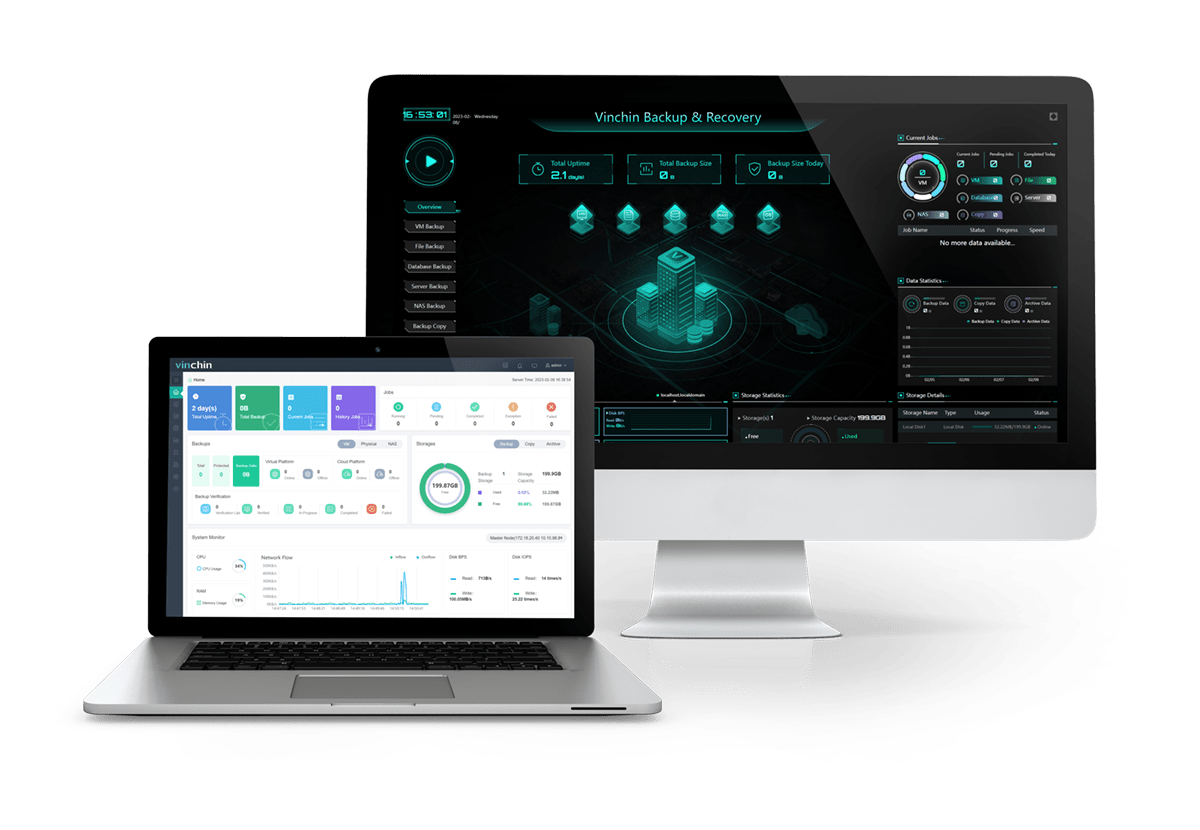-
What is virtual disaster recovery?
-
What is server virtualization?
-
Why is server virtualization important?
-
Challenges facing server virtualization
-
Planning virtual server disaster recovery and backup
-
Choosing a perfect virtual disaster recovery solution
-
Conclusion
In today’s information-driven society, servers have become an indispensable component for businesses and organizations. Servers store a vast amount of critical data and applications, making the occurrence of server failures or disasters a significant threat that can result in substantial losses and disruptions to operations. Hence, it becomes paramount to establish robust server backup and disaster recovery strategies, ensuring the protection and swift restoration of data and business continuity.
What is virtual disaster recovery?
Virtual disaster recovery is a strategy that involves the replication and hosting of physical or virtual servers by a third-party to provide failover in the event of a man-made or natural catastrophe. It utilizes virtualization technology to simplify the disaster recovery process and make it more efficient and less expensive.
Virtualization offers numerous opportunities for achieving more efficient and streamlined disaster recovery. With virtualization, the physical resources of servers are abstracted into logical structures. Processors, memory, and network ports are represented by parameters in configuration files, while hard disks are represented by files stored locally or in shared storage.
Therefore, backing up a virtual machine is akin to replicating a copy of the file and configuration data. Additionally, this supports VM migration, even if the physical hardware is different, which enables easier management of hardware failure issues.
From a holistic perspective, the main benefit of virtualization methods lies in achieving scaled management through consolidation. A significant number of servers, storage, and networking resources can be centrally managed within a resource pool and provisioned on demand. From a disaster recovery standpoint, in the event of a disaster, the resource pool can be configured with additional capacity and network access to aid the recovery of the primary production environment.
What is server virtualization?
Server virtualization is the process of reorganizing a single server into multiple smaller isolated virtual servers. This process doesn’t require new or additional servers. Instead, virtualization software or hardware leverages existing servers and partitions them into several independent virtual servers, each capable of running independently.
A single server can only run one operating system, usually dedicated to a single application or task. This is because most applications cannot effectively collaborate on a single server. As a result, a significant portion of the server’s processing power remains unused. However, when a server is virtualized, it is transformed into multiple virtual servers, each capable of running different operating systems and applications in an isolated environment. This results in less wastage of processing capacity.
Servers occupy physical space, require maintenance, and need to be installed in a cool and dust-free environment. The cost of hardware, maintenance, and cooling often represents a significant expenditure for organizations. In most cases, server virtualization is the optimal way to manage server demands in a data center.
Why is server virtualization important?
Server virtualization is critical because it is much more efficient than using separate servers for each application or task. Virtualization not only reduces the number of physical servers required, but also simplifies their management, lowers the costs associated with housing and maintaining servers, and significantly minimizes resource waste.
Cost minimization
Server virtualization minimizes costs by improving the utilization of existing resources. This reduces the number of physical servers needed, greatly reducing the management costs associated with these servers, and decreasing the energy requirements for running and cooling the servers.
Faster server configuration and deployment
Setting up a separate server for each application typically involves purchasing and installing new physical servers. This process can be time-consuming and often takes weeks. However, with virtual servers, server configuration and deployment are simple and fast as they don't require new servers or installations.
Energy efficiency
Virtualized servers are inherently “green.” Since server virtualization significantly reduces the number of servers required, it lowers energy costs.
Improved Disaster Recovery
Server virtualization enables easier implementation of effective disaster recovery plans. This is because you have the capability to quickly move data or applications from one server to another. A single server can host a large number of virtual machines. And most virtualization software also allows you to test disaster recovery failover, which is nearly impossible with a large number of physical servers.
Challenges facing server virtualization
IT personnel in small and medium-sized enterprises (SMEs) often have to take on multiple roles within their IT department. Even in companies with a few hundred employees, the limited IT staff is responsible for addressing IT technical issues across various departments, including implementing and maintaining networks, servers, and more.
As a result, there are numerous challenges when it comes to implementing and maintaining virtual servers. Here are some of the key challenges they face:
1. Performance issues: Virtualization can sometimes lead to performance issues. This could be due to over-provisioning of resources, where too many virtual machines are allocated to a single physical server, leading to resource contention.
2. Staff training: To efficiently oversee and maintain a virtual environment, IT staff may need supplementary training. This would encompass learning how to supervise and rectify problems in virtual servers, and how to enforce strong security protocols.
3. Focus on Windows environment: Many SMEs primarily rely on a Windows environment, especially for internal applications and virtual machines. Experience with Windows servers and other Windows-centric technologies is valuable and easily transferable, but this expertise may not apply to all virtualization operations environments.
4. Vendor Lock-in: Once you choose a virtualization platform, it can be difficult and costly to switch to another platform. This is because each platform uses its own file formats and technologies.
Planning virtual server disaster recovery and backup
Every virtualization project for each server must incorporate backup and disaster recovery planning to mitigate the risk of losing sensitive business information. A comprehensive plan for backup and disaster recovery should encompass the following steps:
1. Conduct risk assessment and identify critical servers: Begin with a comprehensive risk assessment to identify potential threats and vulnerabilities that could impact the operation of the host servers, considering factors such as physical security risks, power outages, network failures, and data breaches.
2. Define recovery objectives: The RTO defines the maximum allowable downtime, while the RPO determines the acceptable amount of data loss. These objectives will help set realistic recovery goals and drive decision-making throughout the planning process.
3. Develop backup and recovery strategies: Implement robust backup strategies to ensure data integrity and availability. Determine appropriate backup frequencies based on the importance and rate of data changes.
4. Designate a recovery team: Assemble a dedicated recovery team responsible for implementing the virtual server disaster recovery plan. Define roles and responsibilities, ensuring team members are well-trained and familiar with their duties.
5. Establish offsite data replication: Implement offsite data replication to ensure data redundancy and protect against site-level disasters. Utilize technologies such as asynchronous or synchronous replication to maintain up-to-date copies of critical data at secondary locations.
6. Test and validate the plan: Regularly test and validate the virtual server disaster recovery plan to identify potential gaps or shortcomings. Assess recovery time, data integrity, and system functionality to identify areas for improvement. Update and improve the plan based on the test results.
7. Perform regular plan reviews and maintenance: The disaster recovery plan should be a dynamic document that evolves with the organization’s changing needs and technological advancements. Conduct regular reviews and updates to incorporate changes in infrastructure, applications, or business processes. Provide regular training and awareness programs to ensure employees are familiar with the plan and their roles during a recovery event.
You can further perfect your disaster recovery plan according to the disaster recovery plan checklist.
Choosing a perfect virtual disaster recovery solution
Enterprises that have already applied traditional physical backup and disaster recovery are recommended to adopt virtual disaster recovery methods to double protect data.
Vinchin Backup & Recovery is a professional virtual disaster recovery solution which supports data backup of VM like VMware vSphere, Hyper-V, XenServer, XCP-ng, oVirt, RHV, OpenStack, etc. and other data like database, NAS, file server, etc.

It provides smart backup strategy, multithreading transmission and anti-ransomware protection, supporting image-based, agentless backup, fast incremental backup, offsite backup, LAN-free backup and recovery with a performance of saving backup storage space.
Besides, Vinchin Backup & Recovery can migrate VMs across 10+ virtual platforms including VMware, XenServer, and most KVM-based hypervisors. You can easily switch your critical modern IT workloads from one to another to build your own highly flexible IT infrastructure.
Vinchin Backup & Recovery has been selected by thousands of companies and you can also start to use this powerful system with a 60-day full-featured trial! Also, contact us and leave your needs, and then you will receive a solution according to your IT environment.
Conclusion
Server virtualization and virtual disaster recovery are transformative technologies that offer benefits like cost savings, improved efficiency, and enhanced disaster recovery, but also present many challenges. Despite these, the advantages outweigh the drawbacks for businesses that invest in proper planning and training. The future of IT lies in these technologies, which is crucial for business adaptability and resilience.
Share on:








